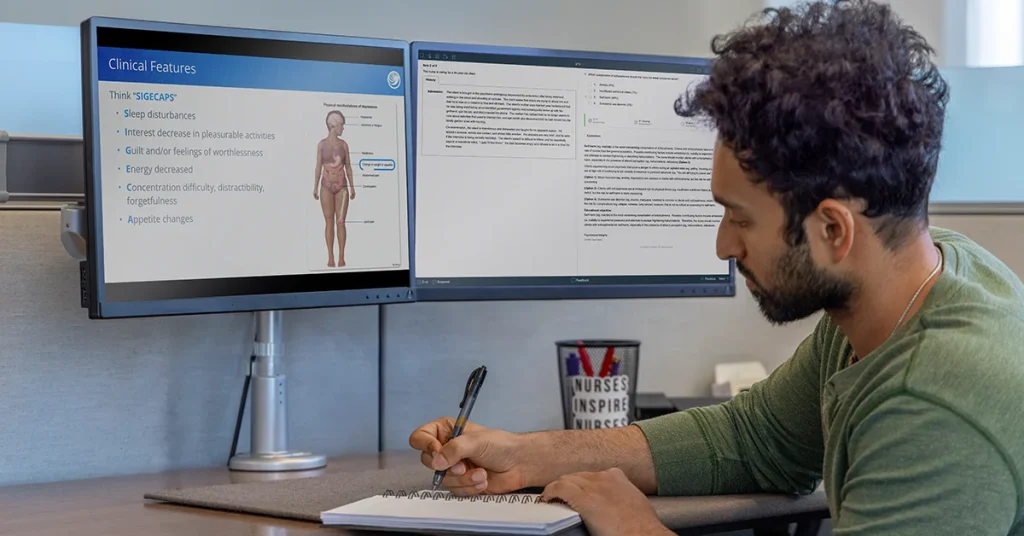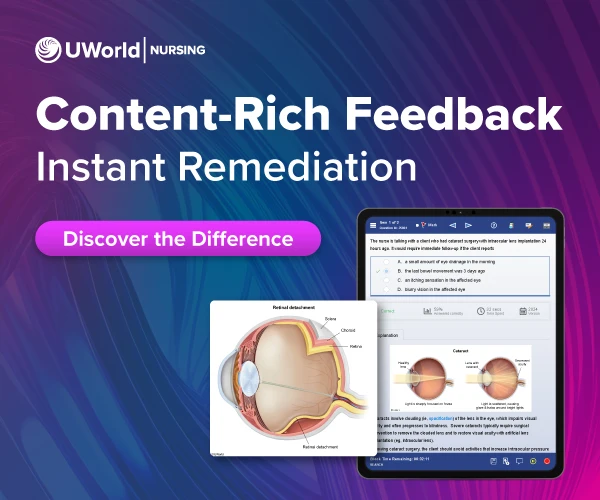Psychiatric conditions often share surface-level symptoms but diverge dramatically in diagnosis and treatment. This overlap makes it especially challenging for nursing students to differentiate them confidently.
Students who fully understand mental health disorders can recognize patterns, think contextually, and call upon genuine clinical empathy. The National Council Licensing Examination (NCLEX®) emphasizes mental health and real-world practice, so equipping future nurses with the tools to deliver rapid, confident assessments is essential.
Why Psychiatric Diagnoses Confuse Nursing Students
Mental health illnesses and psychiatric education present a unique paradox: Students are expected to master highly nuanced diagnoses with limited exposure to real-life client presentations. This can result in confusion and diagnostic blending, especially when:
- Symptoms overlap. Hallucinations, mood changes, and anxiety are not unique to any one disorder.
- Clinical exposure is limited. Many students encounter the less common psychiatric conditions primarily through textbooks.
- Memorization replaces pattern recognition. Without context, facts don’t stick.
- Case presentations are complex. NCLEX items and clinical rotations rarely present a typical case.1-4
Clear Comparisons Make All the Difference
An effective teaching strategy involves direct comparisons. Retention dramatically improves when educators illuminate what makes each disorder different, rather than simply listing symptoms. Students learn to look at mental illnesses holistically, which shapes them into sharp, discerning nursing professionals.5
Schizophrenia vs. Schizoaffective Disorder
At first glance, the symptom presentations for schizophrenia and schizoaffective disorder appear nearly identical, but there is a key distinction leading to the proper diagnosis.
| Symptom | Schizoaffective Disorder | Schizophrenia |
|---|---|---|
| Delusions | ||
| Hallucinations | ||
| Disorganized speech (e.g., frequent derailment or incoherence) | ||
| Grossly disorganized or catatonic behavior | ||
| Negative symptoms (i.e., diminished emotional expression) | ||
| Prominent, persistent mood component (depression or mania) that exists independently6,8 |
✕
|
Bipolar I vs. Bipolar II
Nursing educators often teach mood disorders as a spectrum. While this is a valid approach that reflects current understanding in both clinical and research contexts, it’s equally important to point out clinical thresholds, such as those presented in Bipolar I and II.
| Symptom | Bipolar I | Bipolar II |
|---|---|---|
| Distinct period of abnormally and persistently elevated, expansive, or irritable mood | ||
| Severe manic episodes lasting at least 7 consecutive days |
✕
|
|
| Frequent, prolonged depressive episodes7,8 |
✕
|
Anxiety Disorders vs. PTSD vs. OCD
Anxiety-related disorders such as generalized anxiety disorder (GAD), post-traumatic stress disorder (PTSD), and obsessive-compulsive disorder (OCD) are among the most commonly confused mental health disorders, mainly because all involve heightened stress responses. However, there are notable differences.
| Symptom | GAD | PTSD | OCD |
|---|---|---|---|
| Severe anxiety or trauma triggered by specific stimuli (e.g., events, situations) |
✕
|
||
| Intrusive thoughts (obsessions) | |||
| Frequent mental or physical behaviors — ritualistic in nature — that help to reduce anxiety (compulsions) |
✕
|
✕
|
|
| Frequent flashbacks, nightmares, and hypervigilance |
✕
|
✕
|
|
| Excessive, uncontrollable worry about various aspects of life8 |
✕
|
✕
|
Active Learning Strategies for Mental Health Nursing
Memorization has its place, but for conditions as complex as mental health disorders, active learning methods enhance retention better and prepare nursing students for safe patient interventions:9
- Case-based discussions: Use case studies to help students examine symptom evolution and explain diagnostic reasoning.
- “Which diagnosis fits?” challenge: Present overlapping symptoms and let students debate the best-fit diagnosis.
- Timelines and visual aids: Encourage students to track symptom onset, duration, and fluctuation.
- NCLEX-style item breakdowns: Instruct students to answer topic-based item sets and determine the reasoning behind correct and incorrect selections.

Making Complex Disorders Understandable for Future Nurses
Psychiatric education shouldn’t feel like a guessing game. By prioritizing pattern recognition, patient context, and comparative learning, even the most challenging mental health disorders can be demystified. Reinforcing learning through repetition, discussion, and real-life cases can help students understand their future patients, not simply label them.
References
- National Institute of Mental Health. (2023). Understanding psychosis. www.nimh.nih.gov/health/publications/understanding-psychosis
- Cleveland Clinic. (2023, July 20). Mood disorders. https://my.clevelandclinic.org/health/diseases/17843-mood-disorders
- Günaydin, N., & Çoban, S. A. (2021). Experiences of nursing students during clinical education in mental health clinics: A phenomenological qualitative study. Nurse Education in Practice, 54, 103110. https://www.sciencedirect.com/science/article/abs/pii/S1471595321001499
- Shaygan, M., Jaberi, A., Hosseini, F. A., & Fereidooni Moghadam, M. (2023). How to prepare nursing students for mental health clinical engagement: A qualitative study. BMC Medical Education, 23, Article 672. https://doi.org/10.1186/s12909-023-04657-8
- Jia, Z., & Balinas, J. M. (2024). Teaching strategies in psychiatric nursing based on Bloom’s taxonomy of educational objectives. Cureus, 16(4), e57759. https://doi.org/10.7759/cureus.57759
- Wy, T. J. P., & Saadabadi, A. (2023). Schizoaffective disorder. In StatPearls. StatPearls Publishing. https://www.ncbi.nlm.nih.gov/books/NBK541012/
- Brancati, G. E., Nunes, A., Scott, K., O’Donovan, C., Cervantes, P., Grof, P., & Alda, M. (2023). Differential characteristics of bipolar I and II disorders: A retrospective, cross-sectional evaluation of clinical features, illness course, and response to treatment. International Journal of Bipolar Disorders, 11, 25. https://doi.org/10.1186/s40345-023-00304-9
- Morgan, K. I. (2024). Davis advantage for Townsend's psychiatric mental health nursing (11th ed.). F. A. Davis.
- Pivač, S., Skela-Savič, B., Jović, D., Avdić, M., & Kalender-Smajlović, S. (2021). Implementation of active learning methods by nurse educators in undergraduate nursing students’ programs – a group interview. BMC Nursing, 20, Article 173. https://doi.org/10.1186/s12912-021-00688-y







